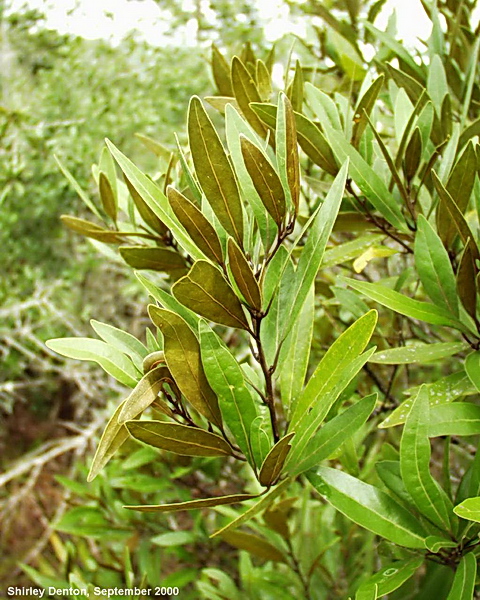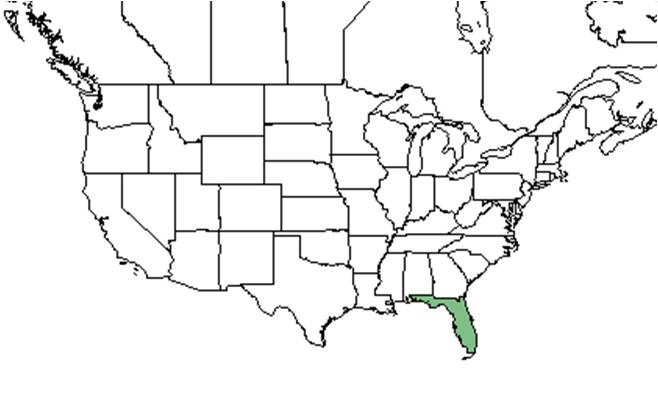Difference between revisions of "Persea humilis"
(→Taxonomic notes) |
(→Ecology) |
||
| Line 37: | Line 37: | ||
It is endemic to rosemary and sand pine scrubs in peninsular Florida <ref name="natureserve">[[http://explorer.natureserve.org/servlet/NatureServe?searchName=Persea+borbonia+var.+humilis]]NatureServe. Accessed: February 20, 2016</ref>. | It is endemic to rosemary and sand pine scrubs in peninsular Florida <ref name="natureserve">[[http://explorer.natureserve.org/servlet/NatureServe?searchName=Persea+borbonia+var.+humilis]]NatureServe. Accessed: February 20, 2016</ref>. | ||
| − | ===Phenology=== <!--Timing off flowering, fruiting, seed dispersal, and environmental triggers. Cite PanFlora website if appropriate: http://www.gilnelson.com/PanFlora/ --> | + | <!--===Phenology===--> <!--Timing off flowering, fruiting, seed dispersal, and environmental triggers. Cite PanFlora website if appropriate: http://www.gilnelson.com/PanFlora/ --> |
| − | ===Seed dispersal=== | + | <!--===Seed dispersal===--> |
| − | ===Seed bank and germination=== | + | <!--===Seed bank and germination===--> |
| − | ===Fire ecology=== <!--Fire tolerance, fire dependence, adaptive fire responses--> | + | <!--===Fire ecology===--> <!--Fire tolerance, fire dependence, adaptive fire responses--> |
===Pollination=== | ===Pollination=== | ||
The following Hymenoptera families and species were observed visiting flowers of ''Persea humilis'' at Archbold Biological Station (Deyrup 2015): | The following Hymenoptera families and species were observed visiting flowers of ''Persea humilis'' at Archbold Biological Station (Deyrup 2015): | ||
| Line 52: | Line 52: | ||
Vespidae: ''Euodynerus apopkensis, Polistes metricus, Pseudodynerus quadrisectus'' | Vespidae: ''Euodynerus apopkensis, Polistes metricus, Pseudodynerus quadrisectus'' | ||
| − | ===Use by animals=== <!--Herbivory, granivory, insect hosting, etc.--> | + | <!--===Use by animals===--> <!--Herbivory, granivory, insect hosting, etc.--> |
| − | ===Diseases and parasites=== | + | <!--===Diseases and parasites===--> |
==Conservation and Management== | ==Conservation and Management== | ||
Revision as of 14:10, 24 March 2016
| Persea humilis | |
|---|---|

| |
| Photo by Shirley Denton (Copyrighted, use by photographer’s permission only), Nature Photography by Shirley Denton | |
| Scientific classification | |
| Kingdom: | Plantae |
| Division: | Magnoliophyta - Flowering plants |
| Class: | Magnoliopsida – Dicotyledons |
| Order: | Laurales |
| Family: | Lauraceae |
| Genus: | Persea |
| Species: | P. humilis |
| Binomial name | |
| Persea humilis Nash | |

| |
| Natural range of Persea humilis from USDA NRCS Plants Database. | |
Common name: silk bay
Contents
Taxonomic notes
Synonyms: Tamala humilis (Nash) Small; Persea borbonia var. humilis (Nash) L.E. Kopp
Also called scrub bay[1].
Description
A description of Persea humilis is provided in The Flora of North America.
The leaf is shiny green on the top, with dense rusty-red hairs on the bottom[1]. These hairs on the lower side of the leaf help reduce water loss.
Distribution
P. humilis is limited to the scrubs of the Florida peninsula[1].
Ecology
Habitat
It is endemic to rosemary and sand pine scrubs in peninsular Florida [2].
Pollination
The following Hymenoptera families and species were observed visiting flowers of Persea humilis at Archbold Biological Station (Deyrup 2015):
Colletidae: Colletes brimleyi, C. nudus
Halictidae: Augochlorella aurata, Augochloropsis metallica
Sphecidae: Bicyrtes quadrifasciata, Cerceris fumipennis
Vespidae: Euodynerus apopkensis, Polistes metricus, Pseudodynerus quadrisectus
Conservation and Management
Cultivation and restoration
Photo Gallery
References and notes
Deyrup, M.A. and N.D. 2015. Database of observations of Hymenoptera visitations to flowers of plants on Archbold Biological Station, Florida, USA.